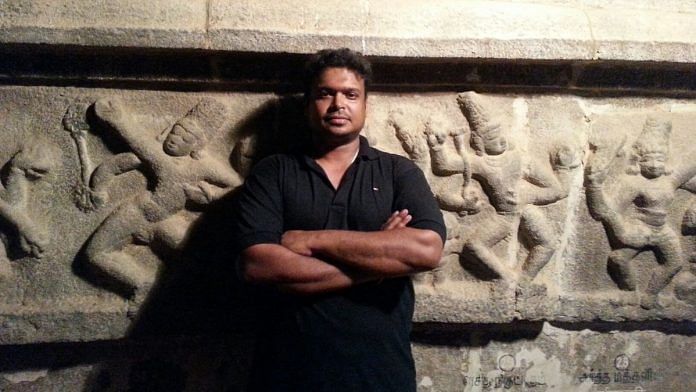New Delhi: S. Vijay Kumar isn’t your regular history and art aficionado.
He started out as a blogger over a decade ago. And now, the Singapore-based art enthusiast has ended up playing a big role — along with an art enthusiast group he co-founded, the India Pride Project — in the restitution of 157 artefacts and antiquities from the US.
On Saturday, the Government of India announced that Prime Minister Narendra Modi will bring the artefacts and antiquities that had been smuggled out of India, from the US after his three-day visit.
The items, which predominantly belong to the period from 11-14 CE, include an exquisite bronze Nataraja from the 12th CE, a 1.5-metre bas relief panel of Revanta (a Hindu deity) in sandstone from 10th CE, and a terracotta vase from the 2nd CE.
A government statement on the restitution said, “PM Modi & President Biden committed to strengthen their efforts to combat the theft, illicit trade and trafficking of cultural object.”
Several Union Ministers, including Piyush Goyal, G. Kishan Reddy and Sarbananda Sonowal, lauded the move.
“Endeavour shows commitment of the Modi Government to bring these back from across the world,” Goyal tweeted. Reddy’s tweet read, “The untiring efforts of @narendramodi govt to repatriate our rightful artefacts that reflect and epitomise the glory of our ancient civilisation continues.”
Among these tweets was one by the Government of India’s Principal Economic Advisor, Sanjeev Sanyal, who highlighted Kumar’s role in the repatriation of the artefacts.
“He is too modest to say this himself, but Vijay Kumar @poetryinstone had a big role in hunting down many of these artefacts. Well done!!!!” he said.
He is too modest to say this himself, but Vijay Kumar @poetryinstone had a big role in hunting down many of these artefacts. Many years of effort tracing these idols across the world. Well done!!!!!!! https://t.co/dvbNSrSRSF
— Sanjeev Sanyal (@sanjeevsanyal) September 25, 2021
In 2014, Kumar and fellow art enthusiast Anuraag Saxena started the India Pride Project, which is focused on the identification and return of such stolen items.
“I would say 95 per cent of the pieces (about 145 of 157 pieces) that are coming back are because of me and my team,” he said.
“This came after a long wait. We were hoping for a bigger number of artefacts, this was a promise that had been made back in 2016 and we are still hoping the number of returned artefacts will now grow.”
Also read: Where are Nazi Germany’s uranium cubes? New tracking method could reveal its missing trail
How it all started
Kumar’s interest in history started early on. “It started young, because I read a book of historical fiction, which my grandmother recommended — Ponniyin Selvan — that was about the Chola period. So I was very inspired by Chola at a very impressionable age,” he said.
Although Kumar, an executive in a shipping company who hails from Chennai, would go on to pursue chartered accountancy as a career, his interest in history and art continued.
The 48-year-old started travelling around India in 2002, visiting several historical sites even while working as an executive in the shipping industry.
“I was basically trying to understand Indian temple art. At that point a couple of friends asked me why don’t you start blogging about it or writing about,” he said.
Kumar, who was by this time living in Singapore, started Poetry In Stone — a bilingual blog written in Tamil and English that contains a repository of information and pictures related to heritage sites, aimed to be a “dummies guide to Indian art”.
“That helped me reach out to a lot of like-minded individuals who had similar interests. And we kind of found a core group and we started visiting sites, to enlarge our learning process,” he said.
All this while he still held down a major shipping company job.
In 2006, when Kumar started the blog he and others started making three to four trips to India every year. Over two years, the repository grew into over 300 posts. From a cave in Tirupparankundram that is likely to have been excavated in early 8th CE to Varaheeswarar temple in Kanchipuram to the Mogalrajapuram caves in Vijayawada, the blog added posts with carefully-crafted details of several historical sites.
“Three-four years later we started realising that by the time we hit the sites, a lot of the artefacts were missing and what was documented were not present…” he said.
So began Kumar’s pursuit for stolen artefacts.
In pursuit of stolen items
The India Pride Project describes itself as a “global network of volunteers and enthusiasts – who are recovering India’s stolen-treasures”.
Behind the group are hundreds of volunteers, “amateur art sleuthers”, who look for stolen art objects, with help from social media, and work towards their restitution to India.
The group’s work has led to the restitution from the UK of the 12th century Buddha stolen from a Bihar museum in 1961, and a 900-year-old Natarajan idol taken from the Brihadeeswara Temple in Tamil Nadu in 2006, which had been sold to the National Gallery of Australia.
However, even before the launch of the group, Kumar and his team had zeroed in on a network being run by art dealer Subhash Kapoor in 2008-09. “They were basically putting a lot of new stuff into museums. The US law enforcement reached out to us and asked for help with identifying the objects,” Kumar said.
Kumar and his team had assisted US law enforcement agencies in the investigation that led to the nabbing of Kapoor.
The New York-based gallerist is believed to have traded over over 50,000 idols, icons, artefacts and antiquities, according to UNESCO estimates.
Several of the artefacts that are being returned are items Kapoor had smuggled along with others, which Kumar had also helped track down.
(Edited by Amit Upadhyaya)
Also read: Australia to return 14 artworks, most bought from jailed smuggler Subhash Kapoor, to India






